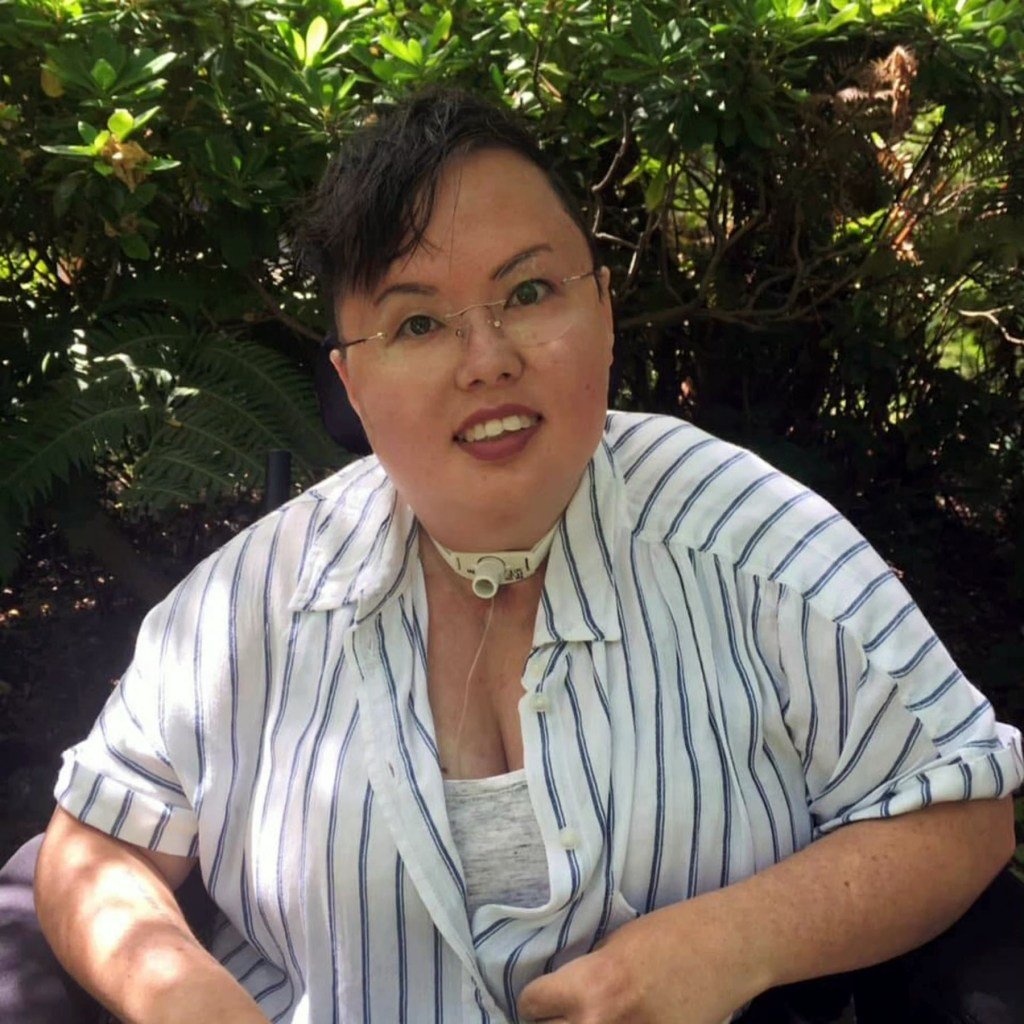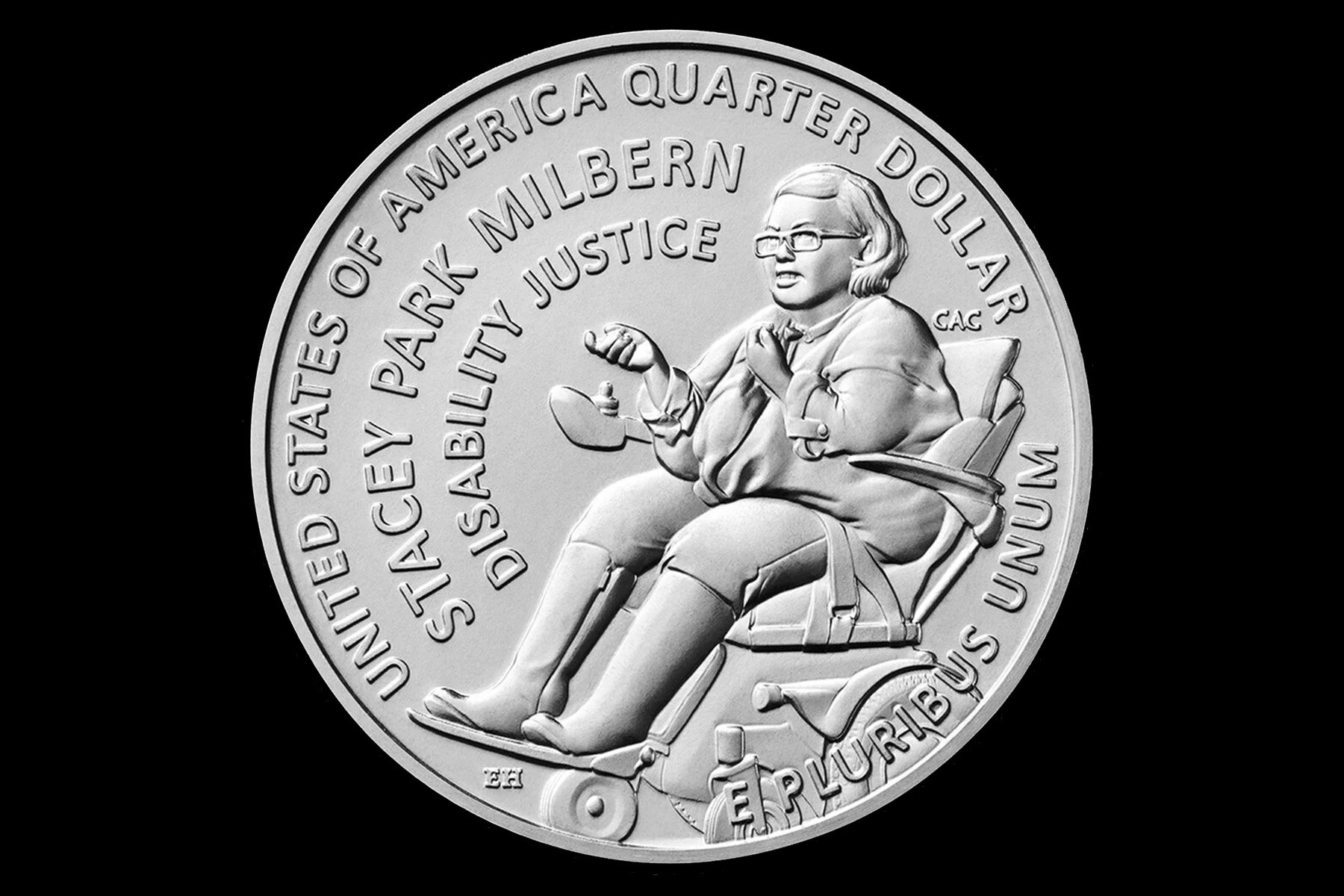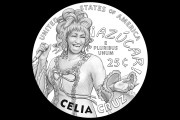The late disability justice co-founder and activist Stacey Park Milbern is the latest pioneering woman to receive her own quarter from the U.S. Mint. Milbern is the first woman in a wheelchair featured on U.S. currency and the first person whose wheelchair is actually shown.
On August 13, nearly 100 disability advocates, family and friends gathered at the Smithsonian National Museum of American History to celebrate the quarter’s release.
“Stacey is not the first wheelchair user on currency. President Franklin Delano Roosevelt has been featured on the dime continuously since 1946, but he is presented as a disembodied head,” Maria Town, president of the American Association of People with Disabilities or AAPD, told The 19th.
Town pointed out that most Americans did not know Roosevelt used a wheelchair for his entire presidency. She emphasized that the visibility of Milbern’s disability is groundbreaking.
“In showing Stacey’s full body, her [tracheostomy tube] and her wheelchair as she is in active communication, Stacey’s quarter presents an extremely different, but more realistic, version of disability than has ever been seen on U.S. currency,” Town said.
Milbern died in 2020 on her 33rd birthday in Stanford, California.
The American Women in Quarters program was introduced through legislation in 2021 with bipartisan support. Eleven thousand women were nominated by the general public to appear on the coins. The U.S. Mint, the National Women’s History Museum and the Smithsonian American Women’s History Museum selected 20. Milbern is the second to last in the series.
-
Read Next:
“These coins help tell the story of our nation through the remarkable women that helped shape it. And we’re proud to help lift up stories like Stacey’s — stories that haven’t always been included, but deserve to be known,” Elizabeth Babcock, director of the Smithsonian Women’s History Museum, said at the celebration. “Stacey was a force for connection and change. She brought people together, connected them around a cause, and organized with purpose.”
Beth Ziebarth, the director of the Smithsonian office of Visitor Accessibility, and Greg Dawson, U.S. Mint associate director for strategy and performance, also spoke at the event. Around 200 people RSVP’d, but some said they chose not to attend out of concern about the increased police and military presence in Washington, D.C. Others, who were simply unable to travel due to cost or attend due to health, participated at watch parties across the country.
They were joined by Milbern’s family, friends and colleagues, as well as a dance performance from the Di Dim Sae Korean Traditional Art Institute, in honor of Milbern’s Korean heritage.
Milbern’s mother, Jean Milbern, highlighted her daughter’s work with the Disability Justice Culture Club, an organization Milbern founded that helped get essentials like masks, sanitizer and even groceries to disabled people who were at the highest risk during the early days of the COVID-19 pandemic.
“Stacey being one of the American Women’s Quarter honorees was beyond our imagination. I want to give glory to God for enabling Stacey to accomplish great things,” she said.

Mia Ives-Rublee, the director of the Disability Justice Initiative at the Center for American Progress think tank, participated remotely due to health reasons. Her initiative is named after the framework Milbern and others created.
“Her work inspires me continuously to continue to think outside of the current structures, to think about how we can create support networks that aren’t just based off of the structures that we have in place today,” Ives-Rublee told The 19th.
Ives-Rublee and Milbern first met through the Women’s March and national disability organizing.
“We started working together during a time when we were protesting. Some of the disability rights leaders took anti-migrant stances while trying to push disability policy. So we got involved and got to know each other through that,” she said.
Ives-Rublee and Milbern had similar upbringings — something that resonated with Ives-Rublee when she began her involvement in disability advocacy.

Support The 19th’s ambitious plans
As part of our three-year strategic plan, we’ll keep showing up in the way you’ve told us you need us to: as your relatable guide to an unequal nation. Your support will help drive our plan forward.
“We both grew up in North Carolina. We’re both Southern. We’re both Asian American. It was so interesting when I got to know about her, because we didn’t grow up far apart from each other. When I got to read about some of the things that she was doing, it provided a feeling like I wasn’t alone,” Ives-Rublee said.
Yomi Young, who worked with Milbern at the Berkeley Center for Independent Living, pointed out the irony of a coin commemorating Milbern’s work — anti-capitalism is a principle of disability justice. Still, she thinks Milbern would have approved.
“As someone who held an anti-capitalist politic, I don’t think Stacey would have ever imagined or advocated to be on a piece of currency. And yet here she is, right? Because it is a tool. It is a vehicle,” Young told the audience at the celebration.
Young sees the quarter as a potential gateway to disability justice for people who have not been exposed to it before.
“As amazing as this coin is, it is not Stacey’s legacy. It is a spark. It is a question in someone’s hand, in someone’s coin purse. Somebody will look at this coin and say: ‘Who is she?’ And the answer will take them straight to her vision, her organizing, her liberation dreams,” Young said.






